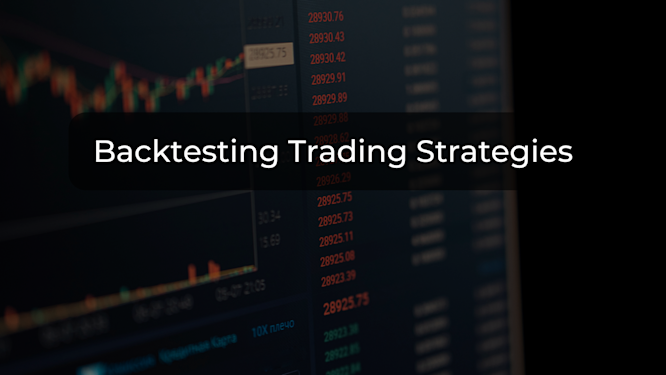A Complete Guide to Backtesting Trading Strategies
Trading Strategies
Backtesting in trading is a powerful method to evaluate how a particular market strategy would have performed in the past. This practice is a cornerstone of strategic development for both novice and experienced traders alike. By using historical data, traders can determine the viability of their strategies, assess their risks, and improve their chances of success. Conducting a thorough backtest of a trading strategy can help identify flaws, strengths, and areas of improvement before a strategy is applied to live trading. In this guide, we will walk you through the process of backtesting trading strategies, highlight important tools to use, and emphasize key considerations to ensure optimal results.
What is Backtesting in Trading?
Backtesting is the process of testing a trading strategy using historical market data. The primary goal is to simulate how a trading strategy would have performed in the past under specific market conditions. By doing so, traders can determine the strategy’s potential effectiveness, optimize it for future use, and identify any weaknesses before risking real money.
At its core, backtesting is essential for creating a successful trading strategy. The market is constantly changing, and what works today might not work tomorrow. Hence, it is important to develop strategies that are robust and adaptable to different market conditions. Through backtesting, traders gain valuable insights into how their strategy would perform in the past and learn from it.
The key to successful backtesting lies in testing strategies that are well-defined. A solid trading strategy provides clear guidelines for trade entry and exit points, trade sizes, risk management rules, and more. Without a structured strategy, backtesting may yield unreliable results that don’t translate to live trading success.
The Importance of Backtesting
Backtesting is important for a number of reasons:
Risk Reduction: Backtesting allows traders to assess the risks associated with a strategy before putting real capital at risk. By understanding how a strategy would have performed in different market conditions, traders can adjust their approach to mitigate risks.
Objective Evaluation: Backtesting provides an objective way to evaluate a strategy’s performance based on data, eliminating emotions and biases. It allows traders to make decisions grounded in facts rather than intuition or subjective analysis.
Strategy Optimization: By analyzing the results of backtests, traders can make adjustments to optimize their strategies. This helps refine the approach and enhances the chances of success in live trading environments.
Testing Multiple Strategies: Backtesting makes it easier to compare multiple strategies against one another. Traders can run different strategies on the same dataset and compare results to determine which is the most effective.
Building Confidence: A solid backtest gives traders the confidence to execute their strategy in real-time trading. Knowing that a strategy has been tested on past data helps to alleviate doubts and reduces the psychological stress of live trading.
Steps to Backtest a Trading Strategy
Backtesting involves several steps that must be completed carefully to ensure accurate results. Below, we walk through these key steps to guide you in backtesting your trading strategies.
1. Define Your Strategy
The first step in backtesting is to clearly define your trading strategy. A well-defined strategy lays the foundation for your backtesting process. It should include:
Entry and Exit Rules: Define when you will enter a trade and when you will exit, either at a target profit or a stop loss.
Indicators and Tools: Specify which indicators or technical tools will be used in the strategy. This could include moving averages, relative strength index (RSI), Fibonacci retracements, or any other technical analysis tool that fits your approach.
Time Frames: Choose the time frame on which your strategy will be based, such as 5-minute charts, daily charts, or weekly charts.
Risk Management: Outline your stop-loss levels, take-profit levels, and position sizing rules. Risk management is crucial, and setting clear limits helps to avoid unnecessary losses.
Having a precise plan is critical, as it ensures that the backtesting process is objective, consistent, and repeatable.
2. Gather Historical Data
The second step is to collect the historical data required to backtest your strategy. Historical data includes market prices, volumes, and other relevant information for the time period you wish to test.
It’s essential to obtain accurate and comprehensive data to ensure that your backtest results are reliable. Many trading platforms, such as MetaTrader, NinjaTrader, or TradingView, provide access to historical data that can be used for backtesting. Alternatively, traders can access specialized data providers for more extensive and detailed datasets.
3. Implement the Strategy
Now that you have your strategy and historical data, it's time to implement the strategy on the data. You can either run the backtest manually by going through the historical data and simulating trades based on your strategy’s rules, or you can use backtesting software to automate the process.
Automated backtesting software can significantly speed up the process and ensure accuracy. Popular backtesting platforms like GoCharting, TradingView, and MetaTrader allow traders to input their strategies and test them using historical data. These platforms can run multiple backtests and generate results instantly.
4. Analyze the Results
Once the backtest is completed, you need to evaluate the results. Key metrics to analyze include:
Profit/Loss: The total amount of money made or lost over the backtesting period.
Win/Loss Ratio: This measures how many trades were profitable versus how many were not.
Risk-Reward Ratio: This ratio indicates whether the risk taken on each trade was worth the potential reward.
Maximum Drawdown: The largest peak-to-trough decline in the equity curve. This is a critical metric for evaluating the worst-case scenario and assessing risk tolerance.
Annualized Return: The average yearly return that a strategy would have generated over a set period of time.
These metrics will give you an understanding of how the strategy would have performed under various market conditions and help identify areas for improvement.
5. Refine the Strategy
After analyzing the results, it’s time to refine your strategy. Look for patterns, strengths, and weaknesses in the data. Is your strategy producing consistent profits, or does it have large fluctuations? Are the risk-reward ratios favorable?
Make adjustments based on the findings:
Modify Indicators: If certain indicators aren’t working as well as expected, consider adjusting them or incorporating additional indicators.
Adjust Risk Management: Fine-tune your stop-loss and take-profit levels to improve the risk-reward ratio.
Tweak Entry and Exit Points: Experiment with adjusting entry and exit criteria to optimize profitability.
Once you make adjustments, backtest again to evaluate the new strategy.
Backtesting with Software Tools
Using backtesting software tools can simplify and automate the entire backtesting process. Tools like GoCharting, MetaTrader, and TradingView offer backtesting features that allow traders to test strategies using historical data.
Backtesting software allows you to input your strategy’s rules, constraints, and indicators and simulate how the strategy would have performed in the past. These tools can provide key performance metrics, visualizations, and reports, which help traders assess the effectiveness of their strategies. The major advantage of using backtesting software is that it automates the process, saving time and ensuring consistent results.
Key Considerations for Backtesting
While backtesting is an essential part of trading, there are several important factors to consider to ensure effective and realistic results:
Data Quality: Ensure that you are using reliable and accurate historical data. Poor quality data can lead to misleading backtest results.
Realistic Assumptions: Always consider transaction costs, slippage, and changing market conditions. These factors can have a significant impact on the actual performance of a strategy.
Avoid Overfitting: Overfitting occurs when a strategy is too finely tuned to past data, making it ineffective in future market conditions. Avoid adjusting parameters too much based on past performance.
Risk Management: Ensure that you apply proper risk management techniques, including stop-loss levels and position sizing. A strategy may appear profitable in backtesting, but poor risk management can lead to significant losses.
Backtesting vs. Paper Trading
It’s important to understand the difference between backtesting and paper trading, as they serve different purposes:
Backtesting: Simulates how a strategy would have performed using historical data. It provides insights into the strategy’s potential effectiveness but does not account for real-time execution issues like slippage or order execution.
Paper Trading: Involves simulating real-time trades without risking actual money. It allows traders to practice executing trades in a real market environment without the risk. Unlike backtesting, paper trading considers real-time factors such as slippage and order execution but lacks the emotional pressure of live trading.
Why is Backtesting Important?
Backtesting is critical because it allows traders to evaluate and refine their strategies before using them in live trading. Without backtesting, traders are essentially gambling with their money, as they don’t have a solid understanding of how their strategy will perform.
By backtesting, traders can:
Identify Weaknesses: Backtesting reveals areas where the strategy can be improved, helping traders optimize their approach.
Improve Risk Management: It allows traders to understand the drawdowns and risk levels involved with their strategy.
Build Confidence: Traders gain confidence by knowing that their strategy has been tested and optimized, reducing anxiety when live trading.
While no method can guarantee future success, backtesting is a crucial tool for traders to evaluate and refine their strategies. Backtesting enables traders to simulate their strategies using historical data, reducing risk and optimizing performance. However, it’s important to use backtesting alongside other metrics and real-time testing methods like paper trading to ensure that strategies are robust and adaptable to changing



